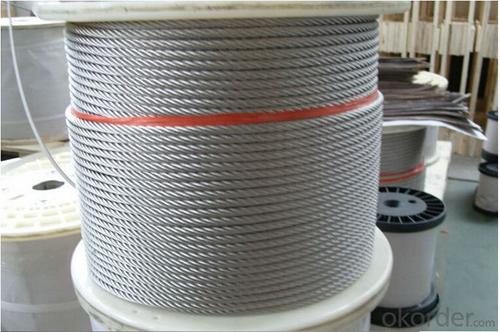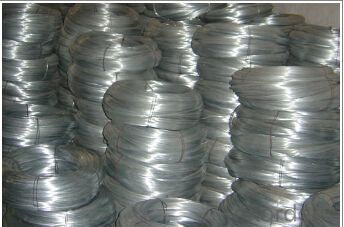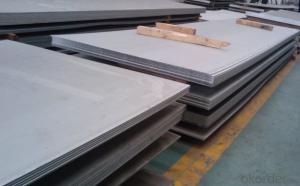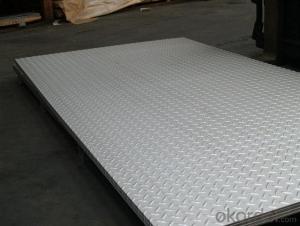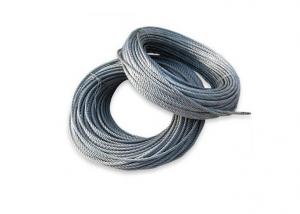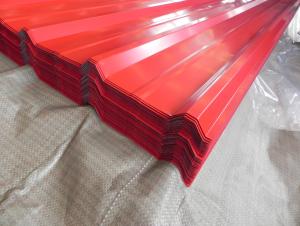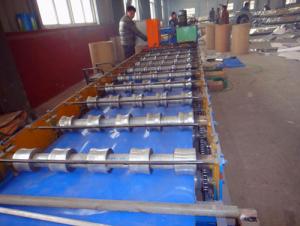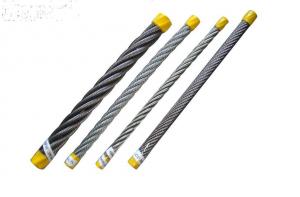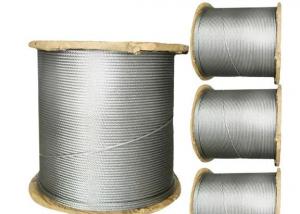Stainless Steel Wire Rope
- Loading Port:
- China Main Port
- Payment Terms:
- TT or LC
- Min Order Qty:
- -
- Supply Capability:
- -
OKorder Service Pledge
OKorder Financial Service
You Might Also Like
Specifications
Product specifications: 0.4-20mm
Packaging Detail: pvc or wooden reel, pallets, wooden box or customized
Stainless steel wire rope
Standard: EN12385-4(DIN3055), GB/T8918-96
Material:AISI 316(L), AISI 304 (L) etc
Material standard:AISI, ASTM, DIN, EN, GB, JIS
Construction: 1*7,7×7, 6×7+FC , 6×19, 7×19,1×7
Tensile strength: 1570N/mm²—1770N/mm²
Dia. range: 0.4mm-20.0mm
Length range:500m/reel, 1000m/reel, or others
Lay directon: R.H.O.L.or L.H.O.L.
Packing:Wrapped in plastic reel or wooden reel, then put on pallets or in wooden box.
Application:Our stainless steel wire rope are widely used in : Aircraft Cable; Automobile Clutch Cable, Control Cables; Telecommunication , Elevators, woven wire sieve, handicraft, wire drawing office equipment,electrical home appliances and raw material, clocks and watches, mechanical equipment,hardware components, etc
FAQ of Stainless Steel Wire Rope :
①How is the quality of your products?
Our products are manufactured strictly according to national and internaional standard, and we take a test on every pipe before delivered out. If you want see our quality certifications and all kinds of testing report, please just ask us for it.
Guaranteed: If products’ quality don’t accord to discription as we give or the promise before you place order, we promise 100% refund.
②How about price?
Yes, we are factory and be able to give you lowest price below market one, and we have a policy that “ for saving time and absolutely honest business attitude, we quote as lowest as possible for any customer, and discount can be given according to quantity”,if you like bargain and factory price is not low enough as you think, just don’t waste your time.Please trust the quotation we would give you, it is professional one.
③Why should you chose us?
Chose happens because of quality, then price, We can give you both.Additionally, we can also offer professional products inquiry, products knowledge train(for agents), smooth goods delivery, exellent customer solution proposals.Our service formula: good quality+good price+good service=customer’s trust
SGS test is available, customer inspection before shipping is welcome, third party inspection is no problem.
Any question, pls feel free to contact us !
Stainless Steel Wire Rope Images
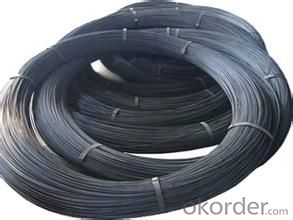
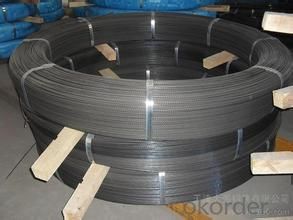
- Q: Can stainless steel sheets be cold rolled?
- Indeed, it is possible to cold roll stainless steel sheets. The cold rolling process involves passing a stainless steel sheet through a sequence of rollers at ambient temperature, leading to a decrease in thickness and an augmentation in both hardness and strength. By employing this technique, one can create stainless steel sheets with accurate measurements and impeccable surface textures. Cold rolling is widely utilized in the production of stainless steel sheets, catering to diverse sectors including automotive parts, kitchen devices, and architectural constructions.
- Q: Do stainless steel sheets have a specific weight?
- Indeed, stainless steel sheets possess a distinct weight. The weight of a stainless steel sheet is contingent upon its dimensions, thickness, and density of the stainless steel substance. In comparison to other metals, stainless steel generally exhibits greater density, resulting in a higher weight for an equivalent volume. To compute the weight of a stainless steel sheet, one can multiply its volume by its density. Typically, the specific weight of stainless steel is denoted in pounds per square foot or kilograms per square meter.
- Q: Stainless steel plate more than the thickness of the wire can not be drawn ah?
- Cold can be the basic drawing, cold always have 6, but can also be hot drawing due to the surface, the surface of the hot rolling drawing look is not obvious, many processing plants also willing to help you fill wire drawing, hot rolled board should be relatively large, artificial lift, so drawing up a lot of trouble....12 thick thought it should be no problem
- Q: What is the width range available for stainless steel sheets?
- The width range available for stainless steel sheets can vary depending on the supplier, but it typically ranges from 36 inches to 72 inches.
- Q: What is called anti fingerprint stainless steel sheet?
- The utility model improves the influence of fingerprints or oil pollution in the use of stainless steel products, and solves the difficult problem that the surface is easy to stick dirt and is difficult to clean. Meanwhile, the utility model avoids the defects of stainless steel surface damage, blackening or losing luster caused by the treatment of fingerprints or oil pollution by common chemical solvents. This is a new type of stainless steel surface processing technology, stainless steel material is not limited: such as 201#, 202#, 301#, 304#, 430#, 443# and so on can be processed!
- Q: Are stainless steel sheets suitable for kitchen countertops?
- Yes, stainless steel sheets are highly suitable for kitchen countertops. They are durable, resistant to stains and corrosion, easy to clean, and provide a sleek and modern look to the kitchen.
- Q: What are the different types of punched finishes available for stainless steel sheets?
- There are several types of punched finishes available for stainless steel sheets, including round hole, square hole, slotted hole, and decorative patterns. Each type offers a unique aesthetic and functional purpose, allowing for customized designs and applications.
- Q: Are stainless steel sheets suitable for food processing and storage?
- Yes, stainless steel sheets are highly suitable for food processing and storage. Stainless steel is a popular choice in the food industry due to its numerous benefits. Firstly, stainless steel is a non-reactive material, meaning it does not release any harmful chemicals or flavors into the food. This makes it safe for storing and processing various types of food, including acidic and alkaline ingredients. Stainless steel is also resistant to corrosion and rust, ensuring the hygiene and longevity of the food products. Moreover, stainless steel has excellent heat resistance, allowing it to withstand high temperatures during cooking and processing without warping or deforming. It also has a smooth and non-porous surface, which makes it easy to clean and maintain. This is particularly important in food processing facilities where maintaining cleanliness and hygiene is crucial. Additionally, stainless steel is a durable material that can withstand heavy usage and frequent cleaning. It is resistant to impact, staining, and scratching, making it ideal for food processing equipment and storage containers that are subject to regular wear and tear. Overall, stainless steel sheets are highly suitable for food processing and storage due to their non-reactive nature, corrosion resistance, heat resistance, easy maintenance, and durability. They provide a safe and hygienic environment for food processing, ensuring the quality and integrity of the food products.
- Q: How do you remove water spots from stainless steel sheets?
- To remove water spots from stainless steel sheets, you can mix equal parts vinegar and water in a spray bottle and spray the affected areas. Let it sit for a few minutes, then wipe it off with a soft cloth. Additionally, you can use a stainless steel cleaner or polish specifically designed for removing water spots.
- Q: Are stainless steel sheets good for industrial exhaust systems?
- Indeed, stainless steel sheets prove to be an exceptional option for industrial exhaust systems. Renowned for its exceptional resistance to corrosion, stainless steel stands as an immensely sturdy and enduring material for exhaust systems. It exhibits the capability to endure high temperatures and withstand extreme weather conditions, hence rendering it suitable for deployment in industrial settings. Moreover, stainless steel showcases outstanding strength, enabling it to cope with the pressure and vibrations inherent in exhaust systems. Furthermore, stainless steel boasts effortless cleaning and maintenance, a crucial attribute for ensuring efficient functionality of the exhaust system. In summary, the durability, corrosion resistance, and high temperature tolerance of stainless steel sheets make them an outstanding choice for industrial exhaust systems.
Send your message to us
Stainless Steel Wire Rope
- Loading Port:
- China Main Port
- Payment Terms:
- TT or LC
- Min Order Qty:
- -
- Supply Capability:
- -
OKorder Service Pledge
OKorder Financial Service
Similar products
Hot products
Hot Searches
Related keywords


